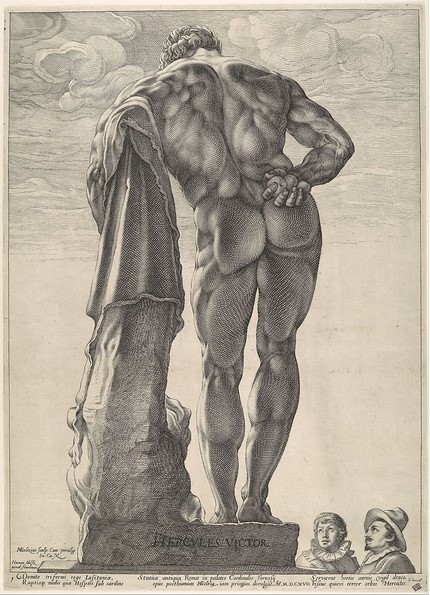Apr 12, 2022
In s2ep17, Ann Shafer and Tru Ludwig talk about one of their favorite engravers of all time, Hendrick Goltzius. A Dutchman, Goltzius was preternaturally gifted with a burin and made glorious prints of all sorts. Ann's favorite is the Farnese Hercules, a large engraving showing two Dutchmen looking up at a giant sculpture of Hercules, which viewers see from behind. Quirky and wonderful, these prints are worth a deep dive.
In s2ep17, Ann Shafer and Tru Ludwig talk about one of their favorite engravers of all time, Hendrick Goltzius. A Dutchman, Goltzius was preternaturally gifted with a burin and made glorious prints of all sorts. Ann's favorite is the Farnese Hercules, a large engraving showing two Dutchmen looking up at a giant sculpture of Hercules, which viewers see from behind. Quirky and wonderful, these prints are worth a deep dive.
Episode image: Hendrick Goltzius (Dutch, 1558–1617). Farnese Hercules, 1617. Engraving. Sheet (trimmed to platemark): 16 9/16 x 11 15/16 in. (421 x 304 mm.). Metropolitan Museum of Art, New York.
Hendrick Goltzius (Dutch, 1558–1617). Goltzius’ Right
Hand, 1588. Pen and brown ink. 9 x 12 5/8 in. (230 x 322 mm.)
Teylers Museum, Haarlem.
Hendrick Goltzius (Dutch, 1558–1617). The Standard Bearer,
Turned to Left, 1587. Engraving. sheet (trimmed to plate
mark): 28.8 x 19.3 cm (11 5/16 x 7 5/8 in.). National Gallery of
Art, Washington, D.C.
Hendrick Goltzius (Dutch, 1558–1617), after Bartholomaeus Spranger
(Netherlandish, 1546–1611). Judith with the Head of
Holofernes, c. 1585. Engraving. Tondo: 6 11/16 in.
Metropolitan Museum of Art, New York.
Hendrick Goltzius (Dutch, 1558–1617), after Cornelis van Haarlem
(Netherlandish, 1562–1638). The Dragon Devouring the Companions
of Cadmus, 1588. Engraving. Sheet (trimmed to platemark): 9
15/16 x 12 1/2 in. (252 x 318 mm.). Metropolitan Museum of Art, New
York.
Hendrick Goltzius (Dutch, 1558–1617). The Great Hercules,
1589. Engraving. Sheet (trimmed to platemark): 21 7/8 x 15 7/8 in.
(555 x 404 mm.). Metropolitan Museum of Art, New York.
Hendrick Goltzius (Dutch, 1558–1617). After Cornelis Cornelisz van
Haarlem (Netherlandish, 1562–1638). Ixion, from the series
The Four Disgracers, 1588. Engraving. Sheet: 13 5/8 x 13
7/16 in. (34.6 x 34.1 cm). Metropolitan Museum of Art, New
York.
Hendrick Goltzius (Dutch, 1558–1617). After Cornelis Cornelisz van
Haarlem (Netherlandish, 1562–1638). Icarus, from the
series The Four Disgracers, 1588. Engraving. Sheet: 13
7/16 x 13 1/4 in. (34.2 x 33.7 cm). Metropolitan Museum of Art, New
York.
Hendrick Goltzius (Dutch, 1558–1617). After Cornelis Cornelisz van
Haarlem (Netherlandish, 1562–1638). Phaeton, from the
series The Four Disgracers, 1588. Engraving. Sheet: 335 x
335 mm (13 3/16 x 13 3/16 in.). Metropolitan Museum of Art, New
York.
Hendrick Goltzius (Dutch, 1558–1617). After Cornelis Cornelisz van
Haarlem (Netherlandish, 1562–1638). Tantalus, from the
series The Four Disgracers, 1588. Engraving. Sheet: 13 1/4
x 13 1/4 in. (33.6 x 33.6 cm). Metropolitan Museum of Art, New
York.
Hendrick Goltzius (Dutch, 1558–1617). The Judgment of
Midas, 1590. Engraving. Plate: 421 x 670 mm. (16 9/16 x 26 3/8
in.); sheet: 430 x 679 mm. (16 15/16 x 26 3/4 in.). Museum of Fine
Arts, Boston.
Marcantonio Raimondi (Italian, c. 1480–before 1534), after Raphael
(Italian, 1483–1520). The Judgment of Paris, c. 1510–20.
Engraving. Sheet (trimmed within platemark): 11 7/16 x 17 3/16 in.
(291 x 437 mm.). Metropolitan Museum of Art, New York.
Hendrick Goltzius (Dutch, 1558–1617). Hercules Killing
Cacus, 1588. Chiaroscuro woodcut. Sheet: 428 x 340 mm. (16 7/8
x 13 3/8 in.). Princeton University Art Museum, Princeton.
Hendrick Goltzius (Dutch, 1558–1617). The Circumcision,
from the series The Birth and Early Life of Christ, 1594.
Engraving. Plate: 18 1/4 x 13 13/16 in. (464 x 351 mm.).
Metropolitan Museum of Art, New York.
Albrecht Dürer (German, 1471–1528). The Circumcision, from
the series The Life of the Virgin, c. 1504. Woodcut.
Sheet: 17 3/16 x 11 15/16 in. (437 x 303 mm.); image: 11 11/16 x 8
1/8 in. (297 x 206 mm.). Metropolitan Museum of Art, New York.
Hendrick Goltzius (Dutch, 1558–1617). Farnese Hercules,
1617. Engraving. Sheet (trimmed to platemark): 16 9/16 x 11 15/16
in. (421 x 304 mm.). Metropolitan Museum of Art, New York.
Hendrick Goltzius (Dutch, 1558–1617). Pietà, 1596.
Engraving. Sheet: 7 1/8 x 5 3/16 in. (181 x 131 mm.). Metropolitan
Museum of Art, New York.
James Siena (American, born 1957). No Man’s Land, 2004.
Engraving on chine collé. Sheet: 437 x 379 mm. (17 3/16 x 14 15/16
in.); plate: 280 x 222 mm. (11 x 8 ¾ in.). Baltimore Museum of Art,
Baltimore.
Hendrick Goltzius (Dutch, 1558–1617). Without Ceres and
Bacchus, Venus Would Freeze, c. 1600–03. Ink and oil on
canvas. 41 3/8 × 31 1/2 in. (105.1 × 80 cm.). Philadelphia Museum
of Art, Philadelphia.


















